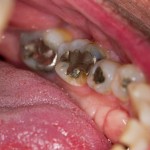
While dental caries has a significant impact on adults much of the research on the prevention of this common disease is focussed on children. The aim of this study was to test the hypothesis that a chlorhexidine (CHX) coating, compared with a placebo coating, reduces dental caries increment in at-risk adults over a period of 13 months.
This was a multicentre, randomised trial with participants receiving either CHX ( 10% weight per volume) or placebo. The treatments were applied by blinded and certified personnel after participants received a rubber cup prophylaxis with non-fluoridated paste and gross scaling as needed. Coatings were applied weekly for 4 weeks and a fifth time 6 months later Cavitated lesions discovered at the fifth visit were restored before the coatings were applied.
The primary outcome measure was caries increment .
The authors found no significant difference between the two treatment arms in either the intention-to-treat or per-protocol analyses.
They concluded that
chlorhexidine is not effective in preventing coronal caries.
Papas AS, Vollmer WM, Gullion CM, Bader J, Laws R, Fellows J, Hollis JF, Maupomé G, Singh ML, Snyder J, Blanchard P. Efficacy of Chlorhexidine Varnish for the Prevention of Adult Caries: A Randomized Trial. J Dent Res. 2011 Dec 7. [Epub ahead of print] PubMed PMID: 22156917.
Related reviews
A recent systematic review by Slot et al identified that there was weak evidence for the effectiveness of CHX on root caries . The authors of this trial also suggested that CHX might have a role in the prevention of root caries in very high-risk populations.
There has also been a systematic review by James et al looking at using CHX for caries prevention in children and adolescents this found inconclusive evidence
Also of relevance is a review from the American Dental Association (ADA) Council on Scientific Affairs (CSA) of non-fluoride agents in caries prevention.
